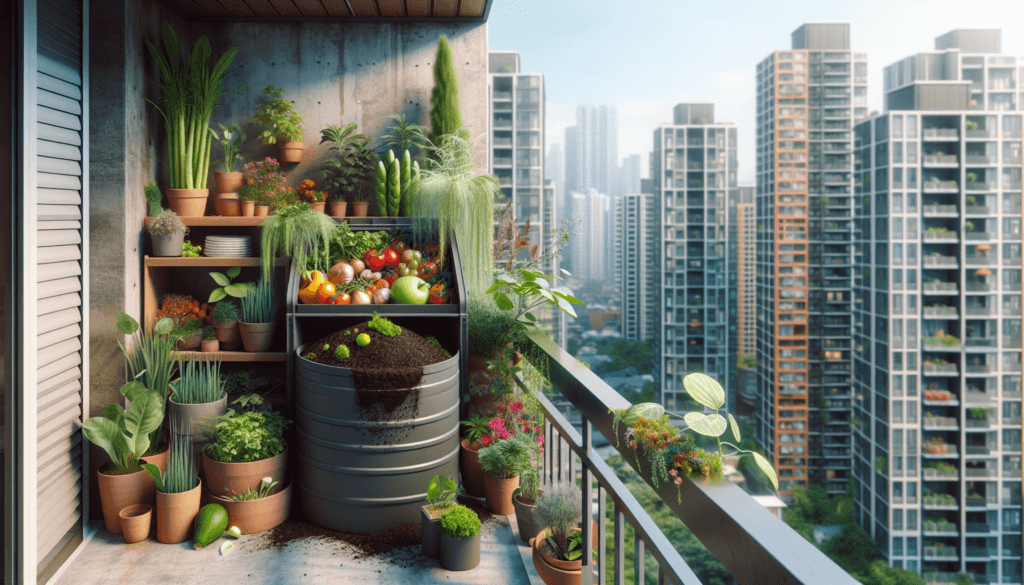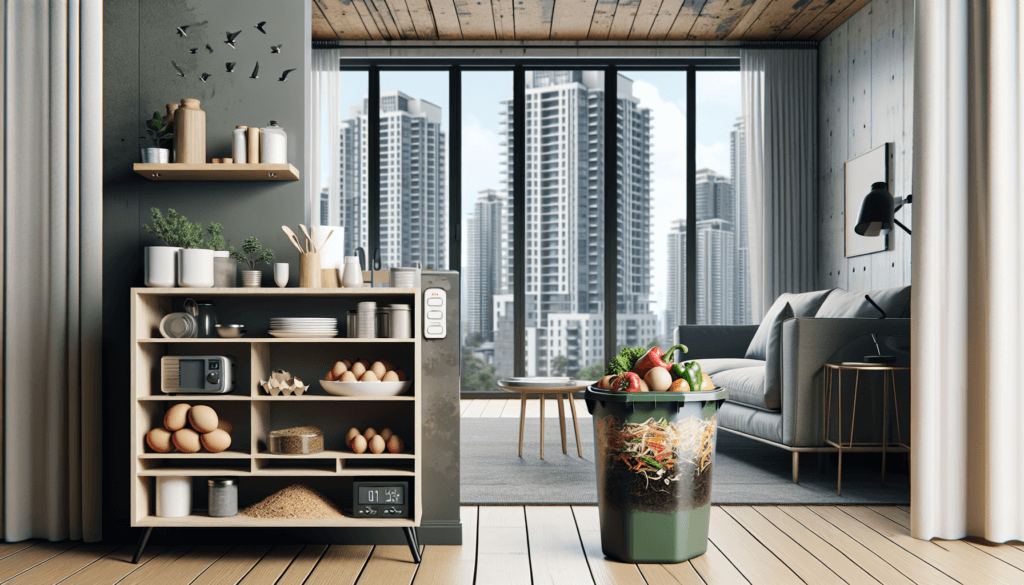Living in an apartment doesn’t mean you can’t do your part in reducing waste and contributing to a more sustainable environment. With urban composting, you can turn your food scraps into rich soil, even without a backyard. In this article, we will share some handy tips and tricks for apartment dwellers who are interested in starting their own composting journey. From choosing the right composting method to managing odor and space constraints, we’ve got you covered. So, grab a cup of coffee and join us as we explore the world of urban composting together!
Getting Started with Urban Composting
Choosing the Right Composting Method
When it comes to urban composting, it’s essential to choose a method that suits your space and lifestyle. There are several options available, each with its unique advantages. Vermicomposting with worms, bokashi composting, trench composting, and indoor composting with a compost tumbler are some of the popular methods for small spaces. Take some time to research and understand each method before deciding which one is best for you.
Understanding the Basics of Composting
Before diving into the different composting methods, it’s crucial to have a basic understanding of the composting process. Composting is the natural breakdown of organic materials, such as kitchen scraps and yard waste, into nutrient-rich compost that can be used to improve soil health and nourish plants. The process requires a balance of carbon-rich materials (known as browns) and nitrogen-rich materials (known as greens), as well as moisture, oxygen, and the right temperature.
Gathering the Necessary Supplies
Once you’ve chosen a composting method and familiarized yourself with the basics, it’s time to gather the necessary supplies. The specific supplies needed will depend on the method you’ve chosen, but here are some essentials to consider:
- A worm bin or compost tumbler
- Redworms (for vermicomposting) or a compost starter kit (for bokashi composting)
- Carbon-rich materials (such as shredded newspaper or dry leaves)
- Nitrogen-rich materials (such as fruit and vegetable scraps)
- A small shovel or pitchfork for trench composting
- A suitable container for indoor composting
Finding Space for Composting
Living in an apartment or small urban space can sometimes make finding room for composting a challenge. However, with a bit of creativity, it’s possible to find suitable spaces even in limited areas. Consider utilizing your balcony, patio, or even a small corner in your kitchen for indoor composting. Trench composting can be done in a garden bed or planter box, while vermicomposting and bokashi composting can be easily done indoors. Assess your available space and choose a method that fits your environment.
Composting Methods for Small Spaces
Vermicomposting with Worms
Vermicomposting, also known as worm composting, is an excellent option for apartment dwellers because it can be easily done indoors without any unpleasant odors. The process involves using redworms to break down kitchen scraps into nutrient-rich worm castings (worm poop) that make excellent fertilizer. Redworms thrive in a controlled environment and can efficiently process organic waste, making vermicomposting an efficient and space-saving composting method.
Bokashi Composting
Bokashi composting is another method suitable for small spaces. It is a fermentation-based process that utilizes beneficial microbes to break down organic waste. The process involves layering kitchen scraps with bokashi bran, a mixture of wheat bran and effective microorganisms. The sealed bin prevents the escape of any unpleasant odors, allowing you to compost conveniently indoors. Bokashi composting is an efficient and odor-free way to turn your kitchen waste into valuable compost.
Trench Composting
If you have limited space outdoors, trench composting can be an ideal option. This method involves digging a trench in a designated area and burying your kitchen scraps and yard waste. The organic materials break down naturally over time, enriching the soil and nourishing nearby plants. Trench composting is a low-maintenance option that maximizes the use of small garden spaces while diverting organic waste from the landfill.
Indoor Composting with a Compost Tumbler
For those who prefer a more hands-off approach to composting, an indoor compost tumbler is a great choice. These compact composting units allow you to compost kitchen scraps and other organic materials without the need for outdoor space. The tumbler accelerates the decomposition process, providing you with nutrient-rich compost in a shorter period. Indoor compost tumblers are odor-free and easy to use, making them a convenient option for apartment dwellers.

Setting Up a Vermicomposting System
Selecting the Right Worms for Vermicomposting
To start a vermicomposting system, it’s crucial to choose the right type of worms. The recommended species for vermicomposting are redworms (Eisenia fetida) or red wigglers. These worms are well-suited for the composting environment and have a voracious appetite for organic waste. You can purchase these worms from a local supplier or online. Make sure to acquire healthy and active worms to ensure the success of your vermicomposting system.
Building or Buying a Worm Bin
Next, you’ll need to set up a proper home for your worms. A worm bin can be easily built using a plastic container with drainage holes, or you can purchase a pre-made worm composting bin. The bin should be shallow and allow for good airflow. Line the bottom with a layer of moistened newspaper or cardboard to provide bedding for the worms. Place the bin in a suitable location, such as under the sink or in a closet.
Creating Bedding and Habitat for Worms
Worms require a comfortable and nutrient-rich environment to thrive. Bedding materials, such as shredded newspaper or coconut coir, provide a soft bedding layer that helps retain moisture. Moisten the bedding material with water until it feels like a damp sponge. Place the bedding in the worm bin and fluff it up to create air pockets. Add the worms on top of the bedding and cover them with a layer of moistened newspaper or cardboard.
Feeding and Maintaining the Vermicomposting System
To keep your vermicomposting system healthy and productive, it’s important to feed your worms a balanced diet. Worms enjoy a mixture of kitchen scraps, such as fruit and vegetable peels, coffee grounds, and crushed eggshells. Avoid feeding them meat, dairy, oily foods, or citrus, as these can attract pests or acidify the bin. Feed the worms regularly, burying the food scraps under the bedding, and ensure the bin remains moist but not overly wet. Regularly harvest the worm castings to use as nutrient-rich fertilizer in your garden or containers.
Getting Started with Bokashi Composting
Understanding the Bokashi Process
Bokashi composting is a simple and effective method that utilizes fermentation to break down organic waste. The process involves layering kitchen scraps with bokashi bran, a mixture of wheat bran and effective microorganisms. These microbes help to accelerate the decomposition process and suppress the odors typically associated with rotting food. The sealed bin prevents oxygen from entering, creating an anaerobic environment ideal for fermentation.
Getting a Bokashi Starter Kit
To get started with bokashi composting, it’s helpful to purchase a bokashi starter kit. These kits typically include airtight bins, bokashi bran, and sometimes a drainage system. The airtight bins are designed to keep the organic waste sealed and odor-free during the fermentation process. The bokashi bran contains the beneficial microorganisms needed for fermentation. Look for a reputable supplier that offers high-quality bokashi starter kits.
Preparing the Bokashi Bran
Before you can begin bokashi composting, you’ll need to prepare the bokashi bran. This can be done by mixing wheat bran with a bokashi starter culture, which contains beneficial microorganisms. In a large container, combine the wheat bran and the bokashi starter culture according to the package instructions. Mix thoroughly until the bran is evenly coated with the starter culture. Allow the mixture to ferment for a few weeks, stirring occasionally to redistribute the microorganisms. Once the bran has a sweet-sour smell, it’s ready to use.
Fermenting Organic Waste with Bokashi
To start bokashi composting, layer your kitchen scraps in the airtight bin with a generous sprinkling of bokashi bran. Ensure that each layer is thoroughly coated with the bran to promote fermentation. Continue layering the organic waste and bokashi bran until the bin is full. Press down on the layers to remove any air pockets and seal the bin tightly. Allow the waste to ferment for two to four weeks, periodically draining the liquid that accumulates at the bottom. The fermented waste can be buried in the soil or added to a traditional compost pile to complete the decomposition process.

Trench Composting in Urban Areas
Identifying a Suitable Trenching Area
To practice trench composting in an urban area, it’s important to identify a suitable location for your compost trench. Look for areas in your garden or yard that have good drainage and receive adequate sunlight. Avoid placing the trench near trees or structures to prevent damage to their root systems or foundations. Ensure there is enough space around the trench for easy access and maintenance.
Preparing the Trench
Once you’ve chosen a suitable area, prepare the trench by digging a hole approximately one to two feet deep and twice as wide as your composting materials. Loosen the soil at the bottom of the trench to promote drainage and aeration. Place the excavated soil to the side, as it will be used to cover the organic waste later.
Adding Kitchen Scraps and Yard Waste to the Trench
Start composting by adding a layer of carbon-rich materials, such as shredded newspaper or dry leaves, to the bottom of the trench. This layer will help absorb excess moisture and provide a carbon source for the decomposition process. Next, add kitchen scraps and yard waste on top of the carbon layer. Alternate between nitrogen-rich materials (such as fruit and vegetable scraps) and carbon-rich materials. Avoid adding meat, dairy, or oily food scraps, as these can attract pests or slow down the decomposition process.
Maintaining the Trench Composting System
To maintain your trench composting system, cover the organic waste with a layer of soil from the excavated trench. This will help contain any odors and deter pests. As the organic materials break down, continue to monitor the moisture level and ensure the trench remains adequately moist. If the composting process slows down, you can add a compost activator or accelerator, such as finished compost or a commercial product, to speed up decomposition. Over time, the organic waste will decompose, and you can use the nutrient-rich soil for planting or gardening.
Indoor Composting with a Compost Tumbler
Choosing the Right Compost Tumbler
When it comes to indoor composting, a compost tumbler is a convenient and space-saving option. There are various compost tumblers available on the market, ranging from small countertop models to larger freestanding units. Consider the size of your apartment and the amount of organic waste you generate to determine the appropriate size of the compost tumbler. Look for a tumbler with good insulation and ventilation, as well as a design that allows for easy turning and maintenance.
Setting Up the Compost Tumbler in Your Apartment
Once you’ve chosen a compost tumbler, find a suitable spot in your apartment to place it. Ideally, the tumbler should be located in an area with good ventilation, away from direct sunlight and extreme temperatures. Place a tray or mat under the tumbler to collect any liquid runoff, as this can be used as a nutrient-rich liquid fertilizer. Ensure the tumbler is secure and won’t tip over, especially if you have curious pets or children in the household.
Balancing the Carbon-Nitrogen Ratio
To achieve successful composting in your indoor compost tumbler, it’s important to maintain a balanced carbon-nitrogen ratio. This means adding a mixture of carbon-rich materials (browns) and nitrogen-rich materials (greens) to the tumbler. Carbon-rich materials include shredded paper, cardboard, and dry leaves, while nitrogen-rich materials include fruit and vegetable scraps, coffee grounds, and grass clippings. Aim for a ratio of roughly 3 parts carbon to 1 part nitrogen to ensure proper decomposition.
Turning and Maintaining the Compost Tumbler
To promote airflow and speed up the composting process, it’s essential to regularly turn the contents of your compost tumbler. This can be done by giving the tumbler a few rotations every couple of days or whenever you add new materials. Ensure the compost remains adequately moist but not overly wet, as excessive moisture can lead to unpleasant odors. If the compost becomes too dry, you can add a small amount of water to restore the moisture balance. Additionally, monitor the temperature of the compost, as a properly functioning tumbler should generate some heat during the decomposition process.

Tips for Successful Urban Composting
Choosing the Right Mix of Organic Waste
When composting in small urban spaces, it’s important to choose the right mix of organic waste. Aim for a combination of carbon-rich materials (such as paper, cardboard, or dry leaves) and nitrogen-rich materials (such as fruit and vegetable scraps or coffee grounds). This balance provides the necessary nutrients and ensures proper decomposition. Avoid adding meat, dairy, oily foods, or citrus, as these can attract pests or slow down the composting process. By selecting the right mix, you’ll create a rich and balanced compost that is perfect for your plants.
Avoiding Composting No-Nos
While composting is generally a forgiving process, there are a few things to avoid to prevent potential issues. Do not add any non-organic materials, such as plastics or metals, into your compost pile or bin, as these will contaminate the compost and take a long time to break down. Additionally, avoid adding weeds or plants that have gone to seed, as this can introduce weed seeds into your compost. Finally, refrain from adding pet waste or human waste, as these can contain harmful pathogens and should be properly disposed of in other ways.
Managing Odor and Pest Control
One concern many apartment dwellers have when it comes to composting is the potential for odor and pests. To manage odor, ensure that your composting system is properly balanced and maintained. Avoid adding any oily, meaty, or strongly aromatic foods, as these can contribute to unpleasant smells. Use a compost activator or accelerator, such as finished compost or commercial products, to speed up decomposition and minimize odor. As for pests, regularly monitor your compost and take measures to deter them, such as keeping the compost covered, adding a layer of mulch, or using natural pest deterrents like diatomaceous earth or vinegar.
Troubleshooting Common Composting Issues
Despite your best efforts, you may encounter some common composting issues along the way. If your compost is too dry, add some water and mix thoroughly to restore moisture levels. If it’s too wet, add more carbon-rich materials to absorb excess moisture. If your compost smells unpleasant, make sure the balance of green and brown materials is correct and consider adding a compost activator. If you notice pests, try covering your compost with a fine wire mesh or introducing beneficial organisms like nematodes or predatory insects. By troubleshooting these issues promptly, you can ensure the success of your urban composting endeavors.
Using Compost in Small Space Gardens
Understanding the Benefits of Compost
Compost is often referred to as “black gold” due to its numerous benefits for plants and soil health. When added to small space gardens, compost improves soil structure, drainage, and water-holding capacity. It enhances nutrient availability, supports beneficial soil organisms, and suppresses plant diseases. Compost also acts as a slow-release fertilizer, providing a steady supply of essential nutrients over time. Using compost in your small space garden will help your plants thrive and contribute to the overall health of your urban environment.
Applying Compost to Container Gardens
Container gardens are a popular choice for small space gardeners, as they allow for flexibility and mobility. When using compost in container gardens, mix it with potting soil to create a nutrient-rich growing medium. Aim for a ratio of one part compost to three parts potting soil. This mixture provides a balanced environment for plant roots, ensuring they receive the necessary nutrients and moisture. Fill your containers with the compost-potting soil mixture and plant your desired herbs, vegetables, or flowers.
Mixing Compost into Potting Soil
For indoor plants or plants in raised beds, mixing compost directly into the potting soil is beneficial. Prior to planting, prepare the soil by adding one part compost to four parts potting soil. Mix the compost and soil thoroughly to distribute the nutrients evenly. This enriched soil mixture will provide the necessary organic matter and nutrients for your plants’ healthy growth. As you plant your chosen plants, ensure the root systems are properly covered with the compost-amended soil.
Top-Dressing Plants with Compost
Another way to utilize compost in small space gardens is through top-dressing. Top-dressing involves applying a layer of compost around the base of established plants. This helps to improve soil structure and replenish nutrients. Gently spread a thin layer of compost around the plants, being mindful not to cover the stems or leaves. As you water or when it rains, the moisture will carry nutrients from the compost down to the root zone, benefiting the plants’ overall health and promoting vigorous growth.

Sharing Compost with Community Gardens
Connecting with Local Community Gardens
Community gardens are fantastic spaces for urban composters to connect with others who share the same passion for sustainable living. Research and reach out to local community gardens in your area. Visit their websites or social media pages, or consider attending gardening events or workshops to meet like-minded individuals. By connecting with community gardens, you can not only share your compost but also gain valuable knowledge and build a supportive network.
Donating Compost to Support Urban Agriculture
If you are producing more compost than you can use or share with friends and family, consider donating it to support urban agriculture initiatives. Many community gardens, urban farms, and sustainable agriculture organizations will gladly accept compost donations. Contact these organizations to discuss your compost donation and arrange for drop-off or pick-up. Donating your excess compost not only diverts organic waste from the landfill but also helps nourish local food production and contributes to a more sustainable urban environment.
Joining Community Composting Programs
Some cities offer community composting programs where residents can contribute to a shared composting initiative. These programs may provide compost bins, pickup services, or drop-off locations for organic waste. By joining a community composting program, you can make a significant impact on reducing organic waste in your area and contribute to the production of nutrient-rich compost. Research if there are any community composting programs in your city and find out how you can get involved.
Engaging in Composting Workshops and Events
To further expand your knowledge and network in the world of urban composting, consider participating in workshops and events related to composting. Many organizations, community gardens, and local governments host workshops and events that cover various composting topics. These events offer opportunities to learn from experts, ask questions, and meet fellow composting enthusiasts. Stay updated with local event calendars or sign up for newsletters to ensure you don’t miss out on these educational and engaging opportunities.
Conclusion
Urban composting is a rewarding and sustainable practice that allows apartment dwellers to reduce their environmental footprint and contribute to soil health. By choosing the right composting method, understanding the basics of composting, and gathering the necessary supplies, you can embark on your urban composting journey. Whether you opt for vermicomposting with worms, bokashi composting, trench composting, or indoor composting with a compost tumbler, there is a method suited to your space and lifestyle. With a little effort and creativity, you can turn your kitchen scraps and yard waste into nutrient-rich compost that benefits your small space garden and the wider community. Take the first step and start urban composting today!



